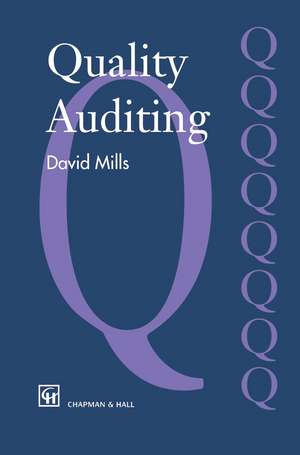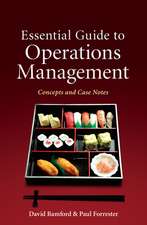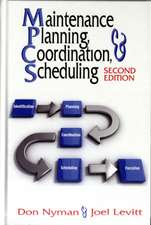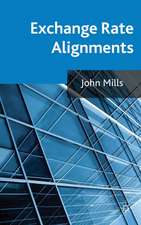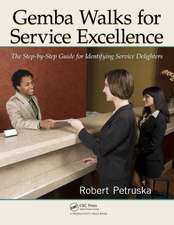Quality Auditing
Autor J. Millsen Limba Engleză Hardback – 30 sep 1993
| Toate formatele și edițiile | Preț | Express |
|---|---|---|
| Paperback (1) | 1218.83 lei 6-8 săpt. | |
| SPRINGER NETHERLANDS – 27 sep 2012 | 1218.83 lei 6-8 săpt. | |
| Hardback (1) | 1224.99 lei 6-8 săpt. | |
| SPRINGER NETHERLANDS – 30 sep 1993 | 1224.99 lei 6-8 săpt. |
Preț: 1224.99 lei
Preț vechi: 1493.90 lei
-18% Nou
Puncte Express: 1837
Preț estimativ în valută:
234.41€ • 245.24$ • 194.72£
234.41€ • 245.24$ • 194.72£
Carte tipărită la comandă
Livrare economică 02-16 aprilie
Preluare comenzi: 021 569.72.76
Specificații
ISBN-13: 9780412458903
ISBN-10: 041245890X
Pagini: 340
Ilustrații: XVII, 318 p.
Dimensiuni: 155 x 235 x 24 mm
Greutate: 0.65 kg
Ediția:1993
Editura: SPRINGER NETHERLANDS
Colecția Springer
Locul publicării:Dordrecht, Netherlands
ISBN-10: 041245890X
Pagini: 340
Ilustrații: XVII, 318 p.
Dimensiuni: 155 x 235 x 24 mm
Greutate: 0.65 kg
Ediția:1993
Editura: SPRINGER NETHERLANDS
Colecția Springer
Locul publicării:Dordrecht, Netherlands
Public țintă
ResearchCuprins
One: An overview of audits.- Where have quality audits come from?.- Auditing status.- Where are quality audits heading?.- Two: What is a quality audit?.- Audit types.- Customer needs.- Audit categories.- Terms and difinitions.- Definitions published in standards.- Applications of definitions.- Three: Why audit?.- Audit objectives.- Compliance.- Effectiveness.- Mandatory audits.- Motivation for audits.- Continuity.- The auditee’s motivation for audit.- Relationships between the audit personnel.- Four: The audit maze.- Categories of audit.- Internal Audits.- External audits.- Extrinsic audits?.- Supplier visitations.- A need for sub-categories?.- Further audit definitions.- Audit types.- Performance audits.- Product audits.- Five: Audit boundaries.- Step 1. Reason.- Step 2. Measures.- Step 3. Coverage.- Step 4. Location.- Step 5. Resources.- Audit depth or involvement.- Resources.- Time.- Manpower.- Facilities.- Skills.- Audit scope decision.- Six: Audit personnel.- Personnel with accountability.- Audit team.- Size of team.- The make-up of a team.- Experts.- Observers.- Team selection.- Audit member’s tasks and responsibilities.- Lead auditor’s general responsibilities.- Lead auditor’s specific duties.- Objectivity of audit personnel.- Seven: Auditor qualifications.- Areas of competence.- Knowledge.- Human factors.- Eight: Audit activities.- The preparation phase.- The data collection phase.- Initial review phase.- The reporting phase.- Nine: The audit plan.- The audit plan.- Who is involved?.- Content of the plan.- Pre-announced or suprise audits?.- Ten: Working methods.- Audit assignments.- Solo auditing.- Auditing in pairs.- Team auditing.- Other team members.- Tasking the auditors.- Auditing tools.- To examine by asking questions.- The tactics of questioning.-Understanding the question.- The form of questions.- The summary question.- I may be stupid but?.- Intervals.- Input vs. output questioning.- Applied questioning.- Verification.- Eleven: Guiding the audit.- Audit checklists.- Aide-mémoire.- Guiding the process.- Lower order working documents.- Other working documents.- Twleve: On-site procedure.- Initial or opening meeting.- Examination.- The exit or closing meeting.- The ‘buffer’ stop situation.- Ethical questions.- Thirteen: Reporting the audit.- ‘In-process’ reports.- Audit results reporting.- Preparation of the report.- Acceptability of the report.- Strength and weakness reporting.- Corrective action.- Presentation of the report.- Fourteen: Problems during the audit.- Pre-audit problems.- ‘On-site’ auditing problems.- Timewasting.- Obstructing the audit.- The auditor’s difficulties.- Fifteen: Finished?.- Corrective action.- A poser for the auditor.- The final solution?.- Sixteen: Special cases?.- What special cases?.- The single product concept.- The case of the tangible vs. intangible.- Generic quality audits.- The case by definition.- The four categories.- Practical applications.- Conclusion.- Seventeen: Managing an audit programme.- The definition of audit programme management.- The functions of audit programme management.- Audit programme management staff.- Policy and strategy.- Provision of audit staff.- Audit team selection.- Audit performance monitoring.- Monitoring auditors’ performance and consistency.- Supplying the required training for auditors.- Audit effectiveness and worth.- Resourcing levels.- Operational review.- Codes of ethics.- Eighteen: Product auditing.- Definition and history.- Developments in product auditing.- Current product auditing processes.- The final goals.- Thecustomer expectation audit (CEA).- Use of the CEA type audit.- The management of a CEA programme.- Nineteen: Economical auditing.- Audit costs.- Sub-contracting the audit.- Systems audit benefits.- Control of systems audit costs.- Product audit benefits.- Control of product audit costs.- Twenty: Auditing at the end of the road.- Past and current status of auditing functions.- A future for the audit role?.- Future auditing methods.- Conclusion.- Twenty-one: Auditing in the ISO 9000 environment.- The first phase revisions.- The ten year review.- Reviews and audits — what’s the difference?.- Compliance with the 9000 series standards.- Understanding the standard’s requirements.- Relationship between quality systems compliance and product quality.- Does poor performance equal lack of conformity?.- Auditing to the ISO 9000 family of standards from the client’s view.- The auditor’s viewpoint and responsibilities.- Audit management.- The role of the consultant.- Integration.- References/Bibliography.
